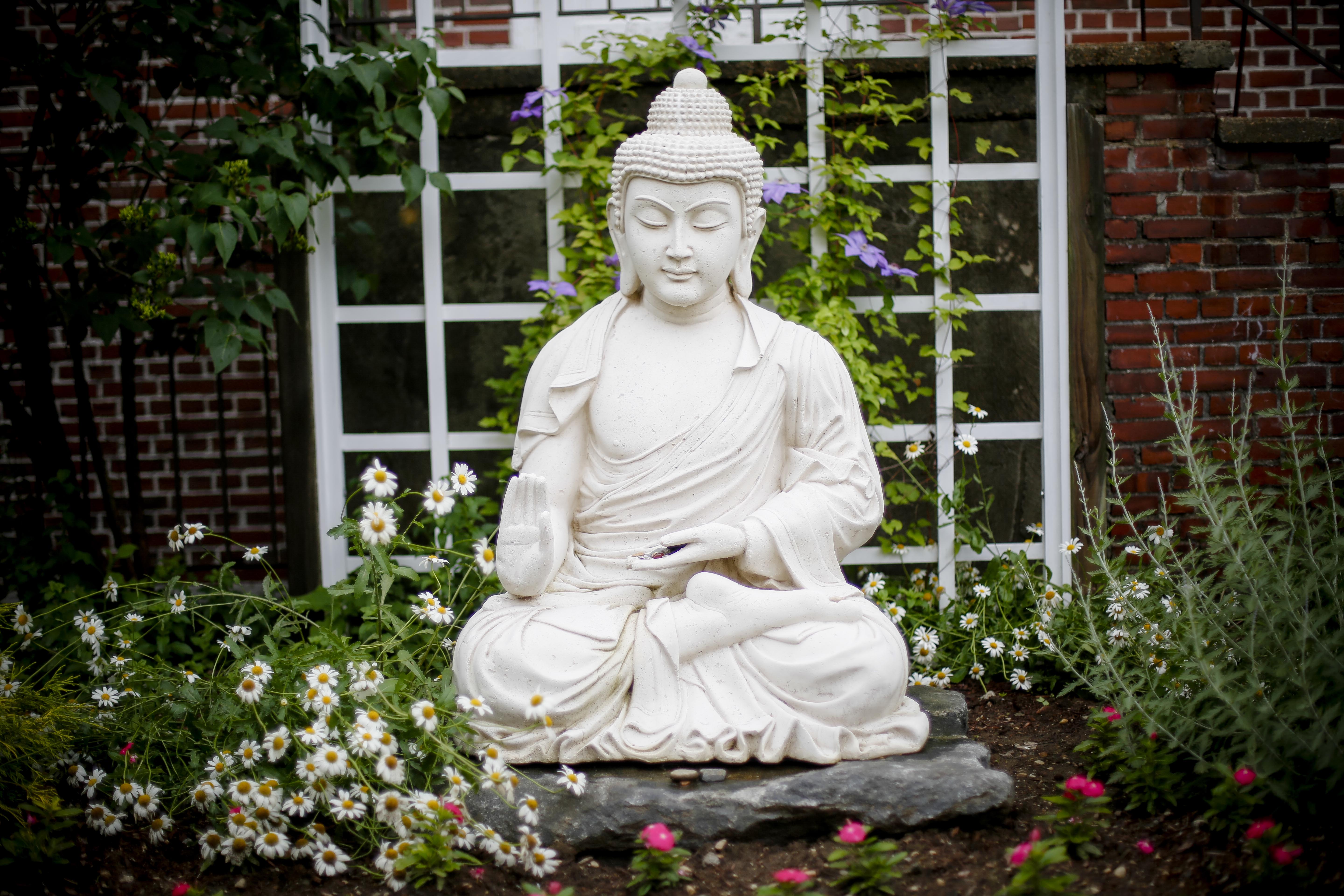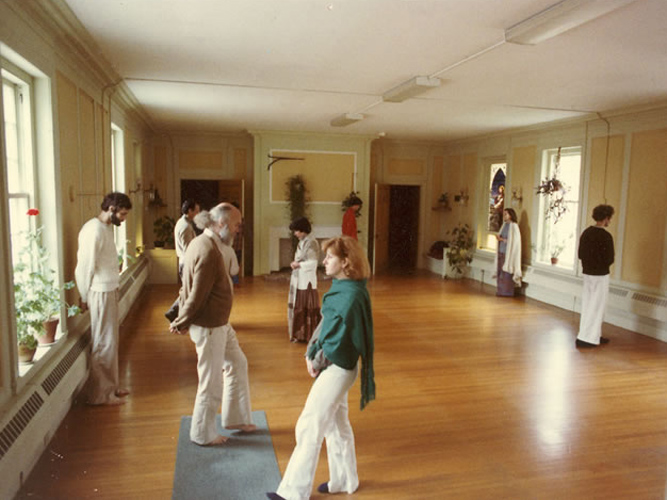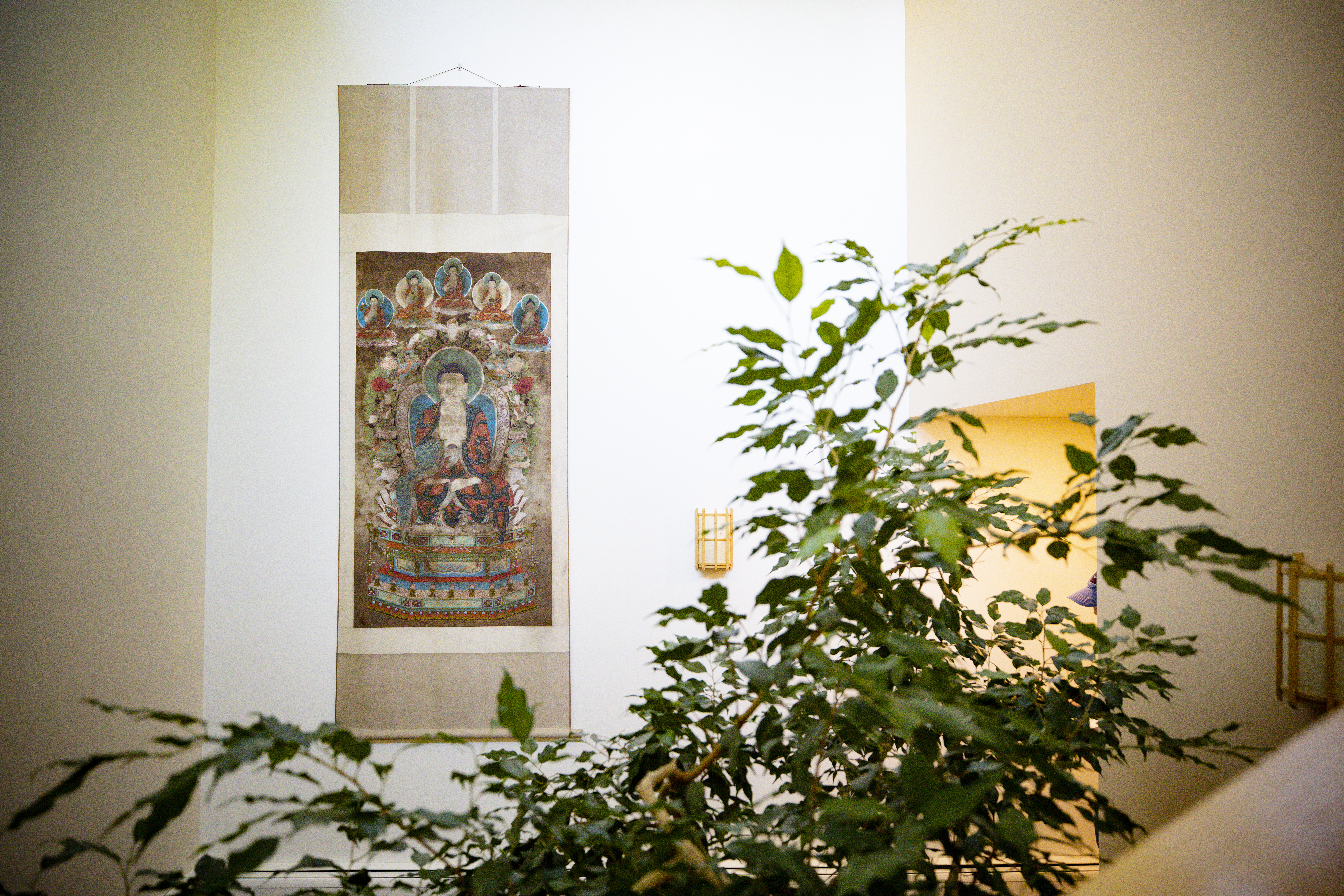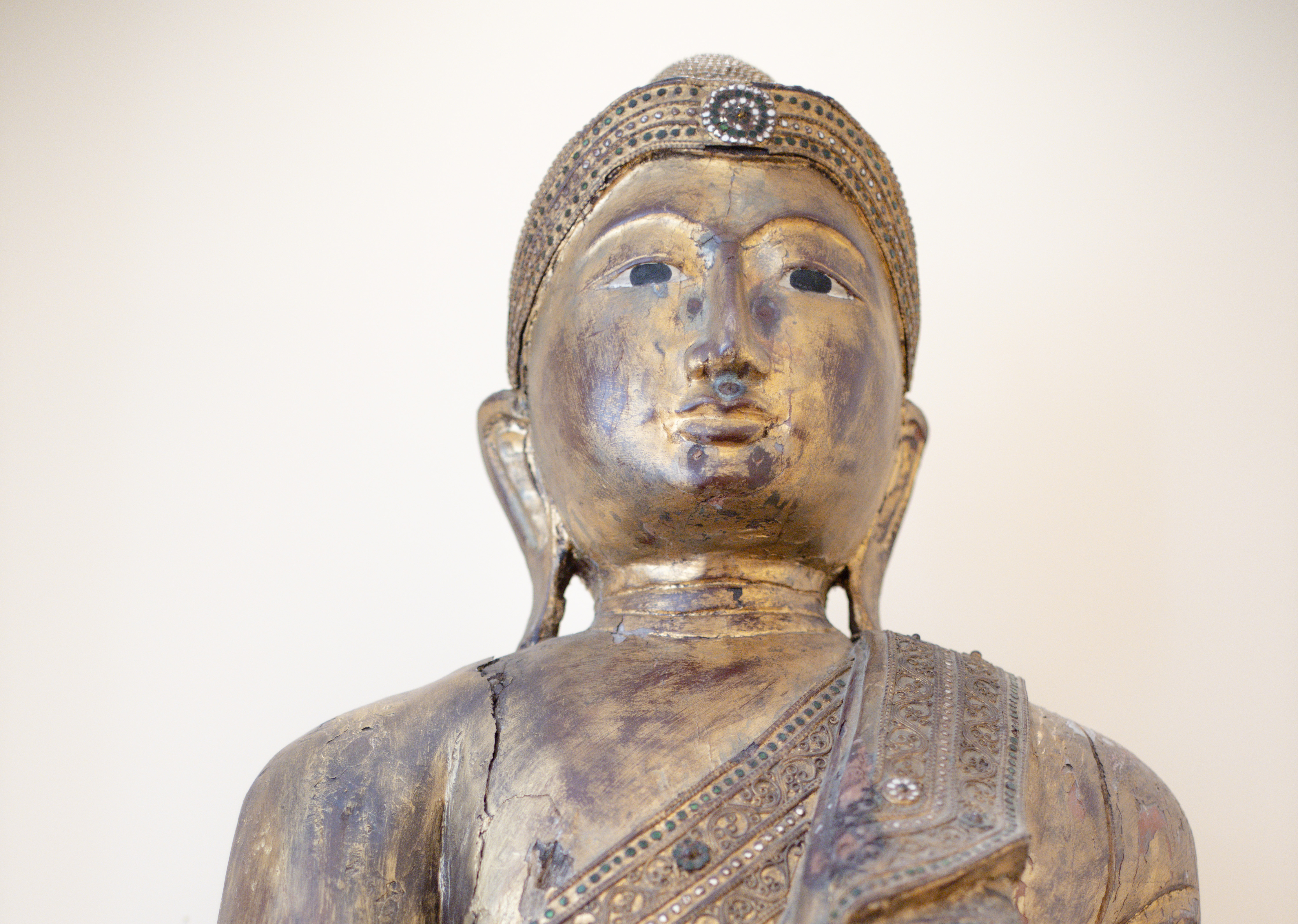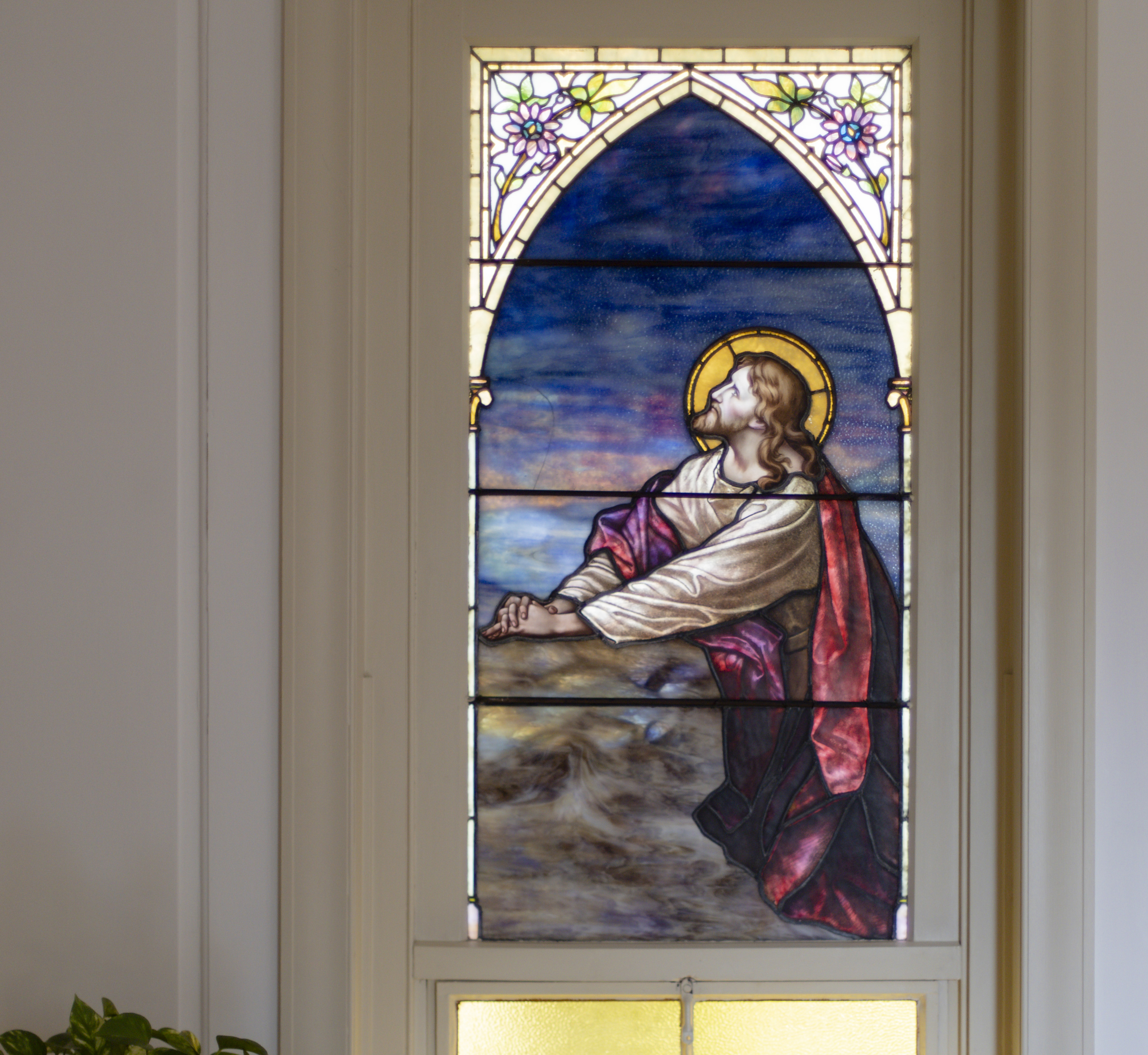
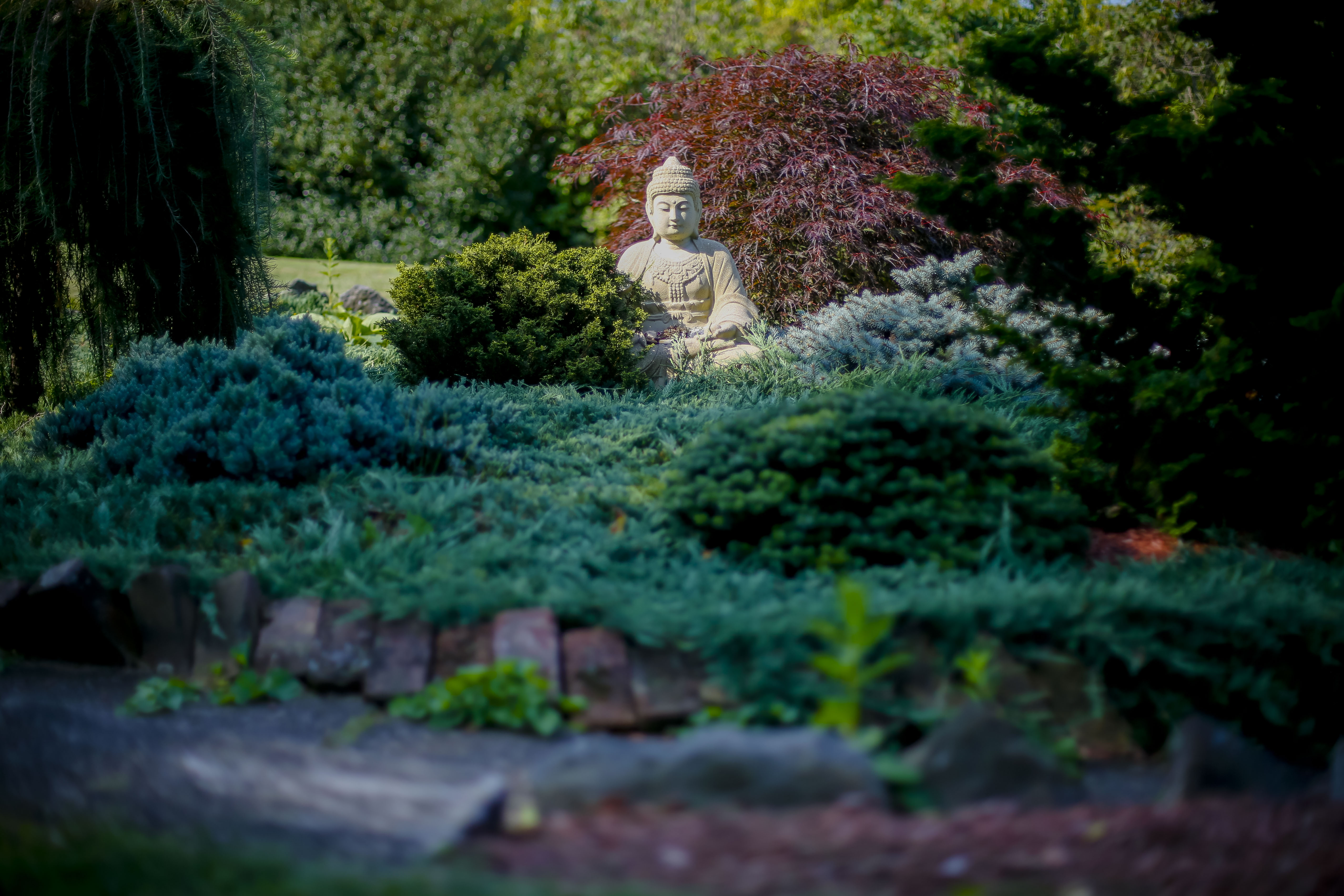
Dozens of statues, thangkas, scrolls, and other devotional items grace IMS’s Retreat Center and Forest Refuge, projecting a calm mental state and reinforcing the Buddha’s teachings about the path leading to the end of suffering. For yogis who are curious about these sacred objects—Where did they come from? How were they made? What purpose did they serve? How might one best practice with them?—direct experience may yield some answers. For example, why do all the Buddha statues appear to be smiling? Because they are enjoying a moment of stillness, undisturbed by a thought. Other mysteries may not be so easily deduced, however—like, why do some seem to be wearing hats covered with bumps? The answer, according to legend: One day, as the Buddha was meditating in the hot sun, 108 passing snails climbed up on his head and formed a cap on his shaved head, so the heat wouldn’t distract him on his path to enlightenment.
Despite the prevalence of Buddhist art on our campus today, IMS’s founding teachers debated whether to display any art at all before the center opened its doors in 1976. “My first teacher in India, S.N. Goenka, said that the Buddha did not teach Buddhism—the Buddha taught a way of life,” recalls IMS co-founder Sharon Salzberg. “And because insight meditation is about cultivating a more mindful response to life, rather than joining a religion or becoming a follower of the Buddha, we asked ourselves, ‘Why put out statues of the Buddha?’”
“The Buddha’s serene posture and inner strength shows us something about ourselves, and about the potential for transformation that’s possible through practice.”—Sharon Salzberg
Ultimately, the recognition that this art amplifies the Buddha’s teachings and conveys the energy of refuge won out. “We believed the Buddha’s serene posture and inner strength shows us something about ourselves,” Sharon says, “and about the potential for transformation that’s possible through practice.” There was also a desire among IMS’s founders to honor the long history and tradition of the teachings they brought back to the United States after their years of practice and study in Southeast Asia in the late 1960s and early 1970s. As Sharon often says, “We didn’t just make these teachings up.”
Much of IMS’s art in the early years was acquired by co-founder Jack Kornfield, who began collecting Buddhist art in Southeast Asia after his stint in the Peace Corps in the late 1960s. “I didn’t know what I was going to do with all this art when I got it, I just knew that I loved it,” Jack recalls. “Because I was planning to stay in Thailand to become a monk, I shipped it all home to my mom, who stored it in her attic.” Once IMS opened, and differences of opinion about graven Buddhist images had been resolved, Jack retrieved his trove from his mother’s home and placed the objects in various rooms throughout the Retreat Center. Over the years, the objects at the Retreat Center and Forest Refuge have come from donors too numerous to list, many of whom prefer to remain anonymous.
The abundance of art at IMS is one of the many joys of spending time here. You never know which pieces will speak to you, excite your curiosity, and call you back to them again and again over the course of a retreat. It might be the Chinese stone Buddha in the circular garden out front at sunset. Or the cracked Kwan Yin that exemplifies how imperfection can enhance beauty. Or the little gold Buddha in the dining room, hands folded in dhyana, or samadhi, mudra, glowing softly in the darkness before sunrise as you sip tea and prepare for the first sit of the day.
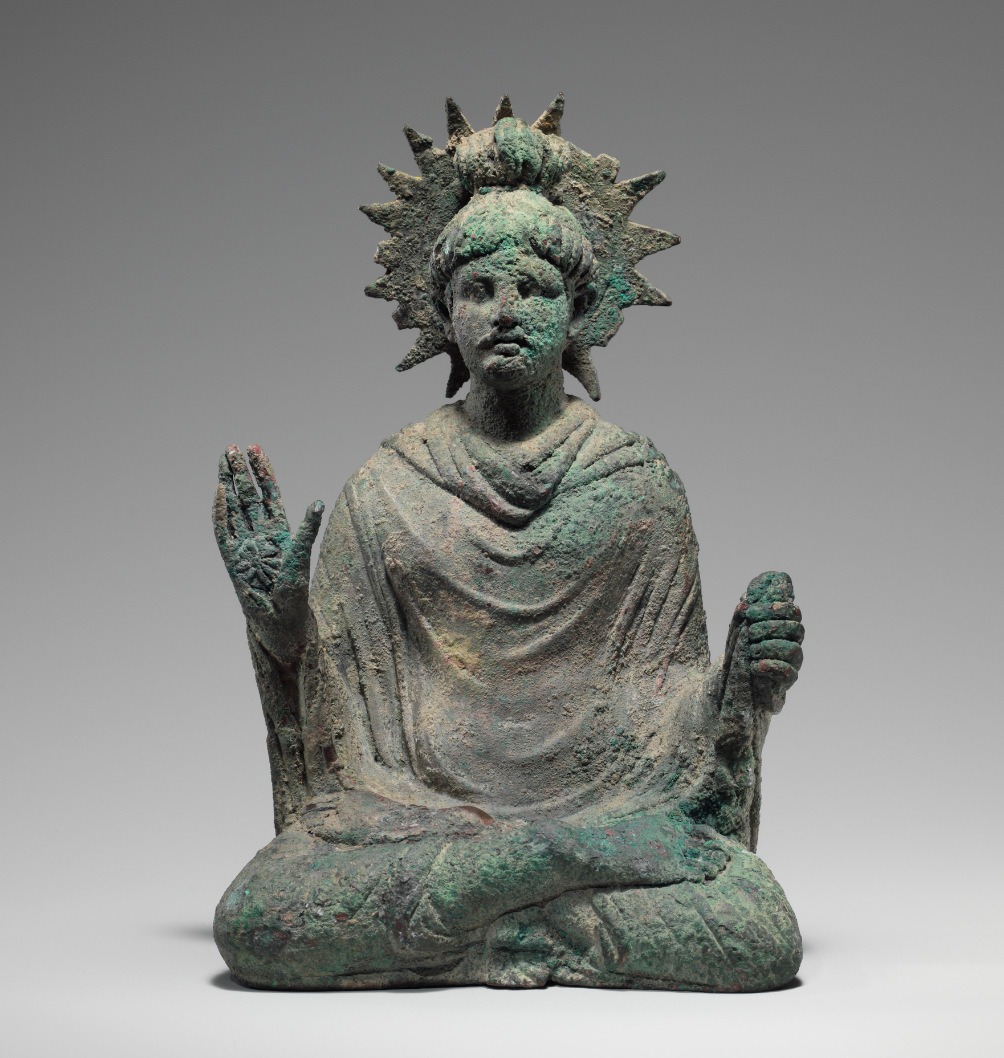
The evolution of Buddhist art has traditionally been thought of as having two periods. Art from the aniconic phase, during the several hundred years following the death of the Buddha, portrayed the events of the Buddha’s life rather than the Buddha himself, through images such as his footprints (Buddhapada) imprinted with the dharma wheel (dharmachakra), a riderless horse, an open royal umbrella, and an empty seat under the Bodhi tree where he achieved enlightenment. The idea was that the Buddha had attained parinirvana (nirvana after death) and been released from the cycle of samsara, karma, and rebirth, so it would have been misleading to suggest that he still existed in human form.
Beginning in roughly the 2nd century BCE and continuing through today, the iconic phase of Buddhist art encompasses representations of the person of the historical Buddha—Buddha Shakyamuni, “sage of the Shakya clan.” Depictions of Shakyamuni Buddha first emerged in Gandhara, an ancient region in what is now northern Pakistan, where Buddhist, Greek, Roman, and other cultures mixed. That accounts for the Buddha’s Greco-Roman appearance in many sculptures from this region, notable in his hairstyle, draped robes, and facial features. The Metropolitan Museum of Art in New York has what is likely one of the oldest iconic representations of the Buddha from Gandhara. Seated in a yogic posture and holding his right hand in abhaya mudra—a gesture of approachability—this small bronze looks less like any Buddha you’ll find at IMS and more like the neoclassical Statue of Liberty, especially given its green hue and serrated halo.
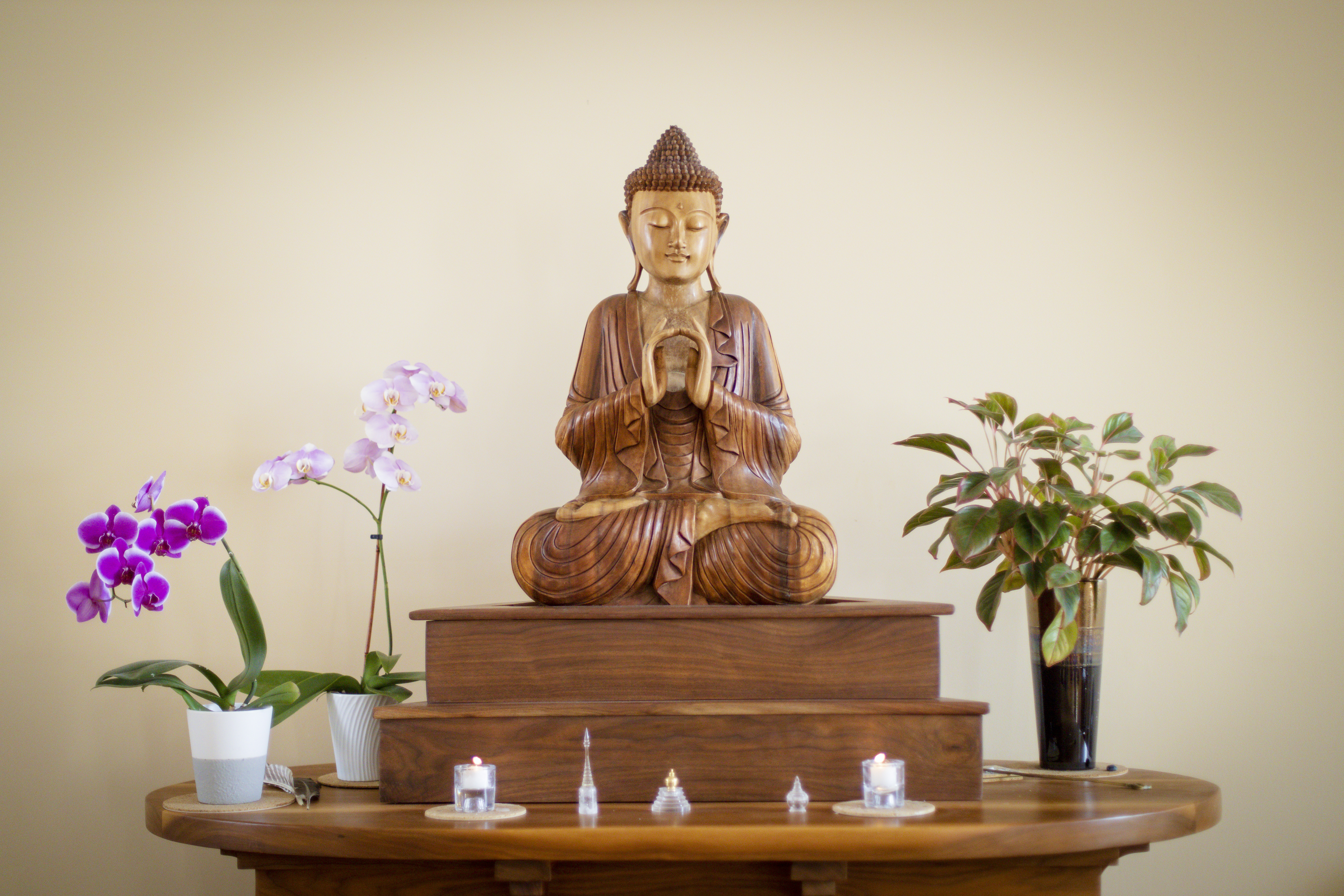
Retreatants returning to the Retreat Center for the first time since IMS reopened last fall may be surprised by the sight of a new wooden Buddha adorning the altar in the meditation hall. Donated to IMS last summer by Melanie Rose, a meditator living in Amherst, Mass., the new Buddha is originally from Bali. Hand-carved from suar wood in the 1990s and depicting the uttarabodhi (“supreme enlightenment”) mudra, it is warm, richly textured, and larger than its bronze predecessor. IMS co-founder Joseph Goldstein loved Melanie’s gift, and felt it was the perfect replacement for the smaller bronze Buddha that formerly sat here. “The new Buddha is quite striking, and it’s easier to see from anywhere in the hall,” Joseph says.
“The new Buddha is quite striking, and it’s easier to see from anywhere in the hall.”—Joseph Goldstein
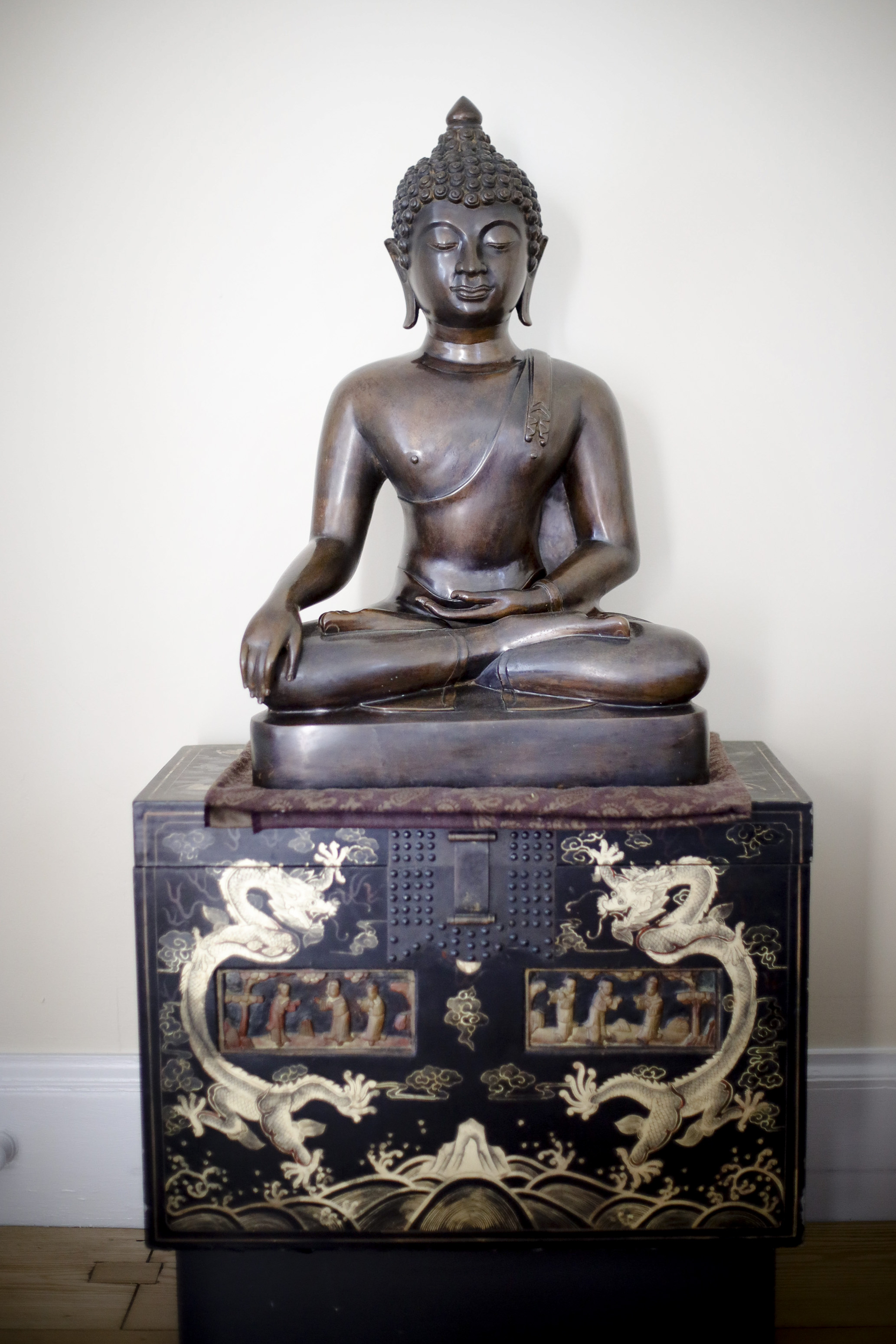
Acquired by Jack in Thailand in the early 1970s, this seated Buddha pictured to the right has been the focal point of countless retreats since taking its place on the altar in the meditation hall when IMS opened. It’s now been moved from the meditation hall to the interview room at the end of the hall on the Retreat Center’s second floor. This Buddha is likely Burmese, given the roundness of his face and small ushnisha (the bump or “turban”) atop his head, symbolizing the Buddha’s regalness, the power of his enlightenment. By contrast, Buddha sculptures reflecting the Sukhothai style, considered the “golden era of Thai art” beginning in the 14th century, featured smooth, sinuous bodies, with elegant lines and slender oval faces. Sukhothai Buddhas typically have a flame on top of their ushnisha, representing spiritual energy, or knowledge.
Seated Buddhas in this style feature the bhumisparsha mudra, or earth-touching gesture, with all five fingers of the right hand extended toward the ground, while the Buddha’s left hand rests palm upward in his lap. The earth-touching gesture represents the prelude to the Buddha’s awakening, when he was attacked by Mara’s army of demons, a metaphor for the temptations of the five hindrances, and in response the Buddha called upon the Earth to bear witness to his right to attain enlightenment by virtue of his innumerable acts of compassion over many lifetimes. When he did this, thunder roared, the Earth shook, and the Buddha attained enlightenment.
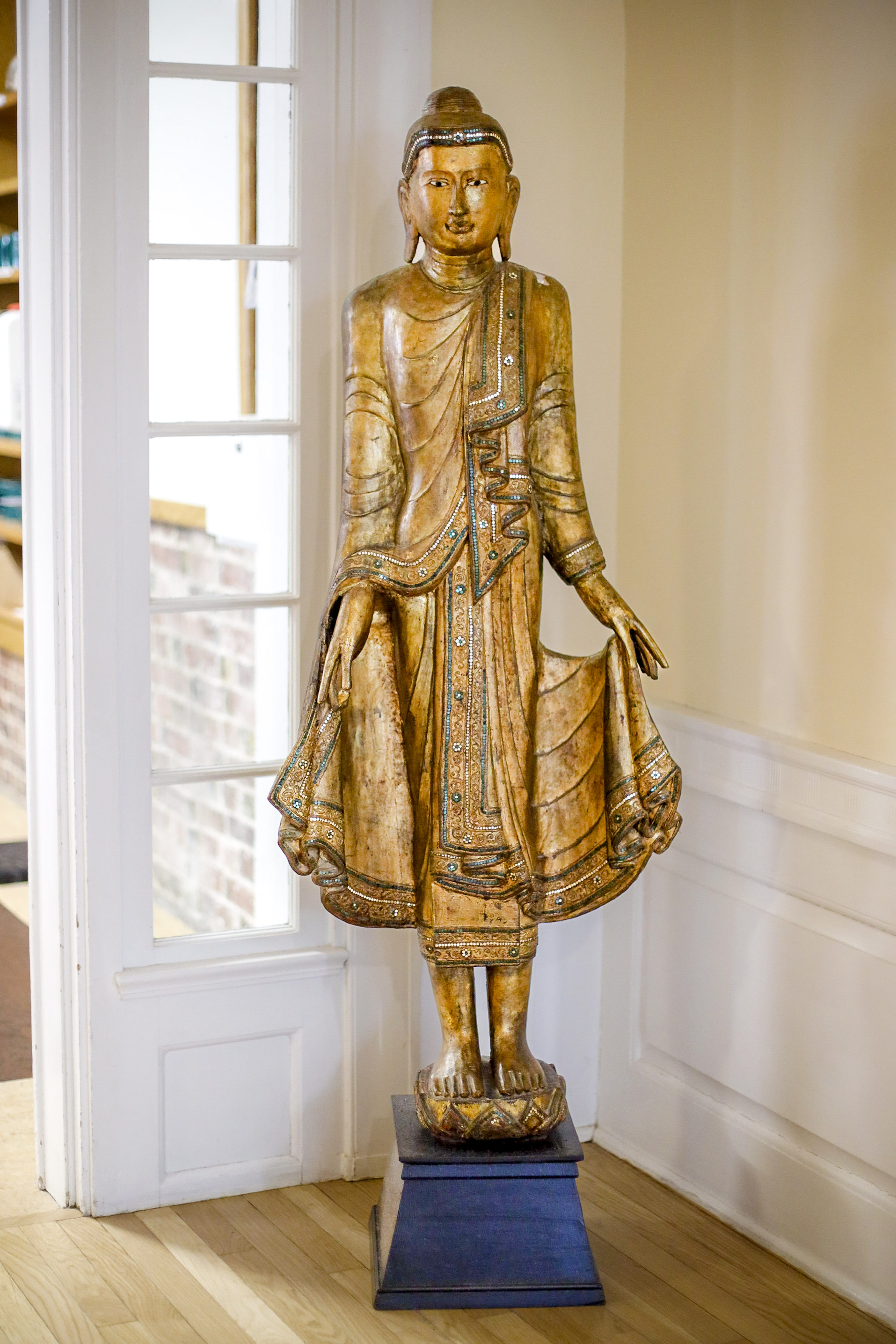
The standing Buddha that yogis pass as they walk from the foyer into the dining room at the Retreat Center is another sculpture Jack acquired in northern Thailand, near the Thai-Burma border. “It’s difficult to say which country that piece originally came from, because Thai and Burmese art are intermingled along the border,” Jack says.
This figure is in the style of a Mandalay Buddha, named for the royal capital of 19th-century Myanmar. Typically carved of wood and gilded, Mandalay Buddhas are sweet-faced and youthful, almost childlike, and clad in ornate flowing robes that typically cover the chest and arms. Other features of this Buddha are common across styles. His ears are long, signifying that the Buddha was a prince, having worn heavy jewelry that stretched his lobes.
If you look closely at the long fingers of this Mandalay Buddha’s right hand, you’ll see a small object between his middle finger and thumb. It’s a piece of fruit known as a myrobalan, or arura in Sanskrit, highly regarded in Ayurvedic and naturopathic medicine for its healing properties. Buddhas holding this fruit, or perhaps a bowl, in their right hand signify that this is a “medicine Buddha”—the Buddha being one who heals suffering by showing the path to liberation.
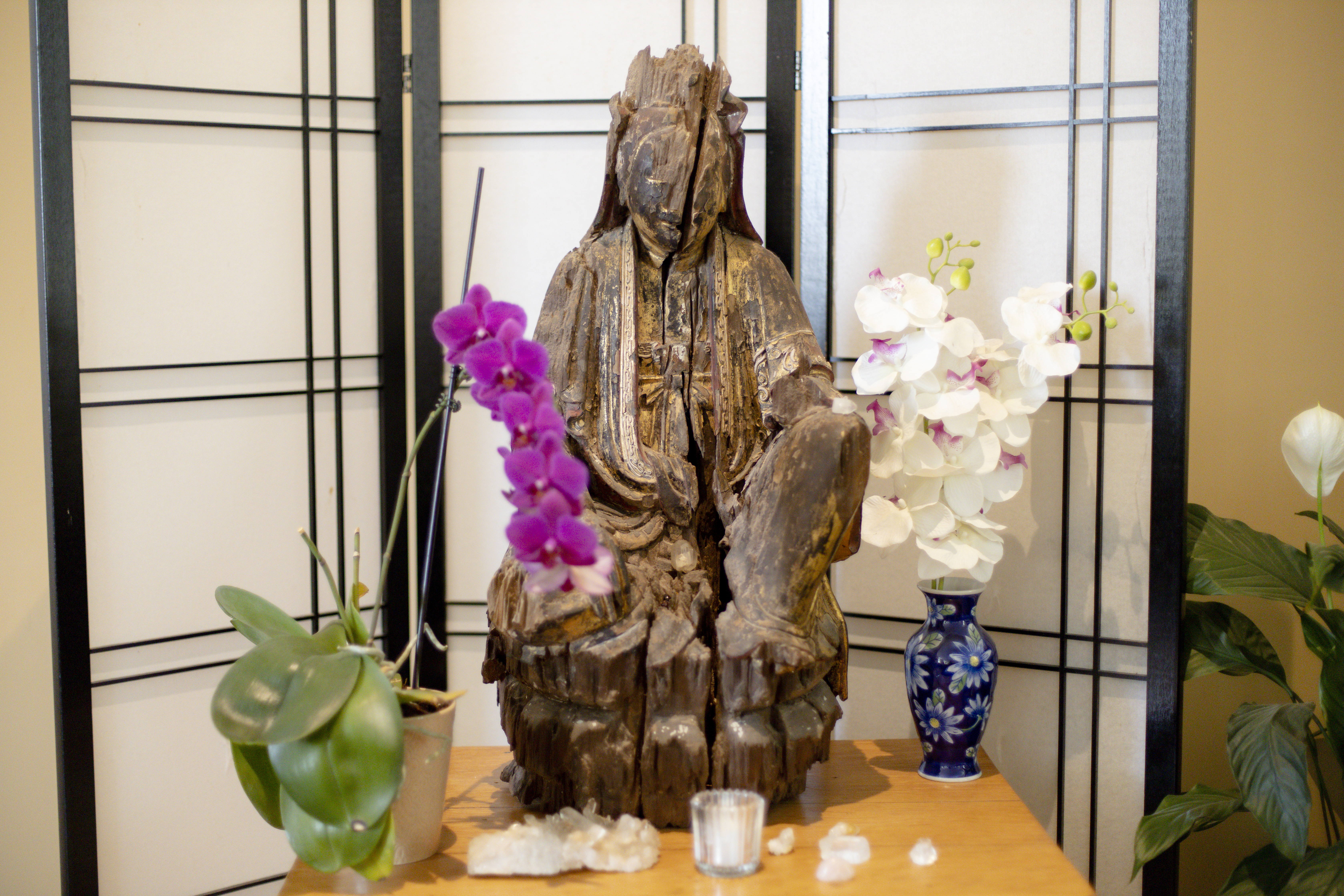
After an IMS retreat Sharon led many years ago, a yogi who happened to be an art dealer from Bangkok approached her and said he was going to send IMS a “gift” when he got home. Sharon didn’t give this kind gesture further thought until, months later, a massive crate was delivered to IMS. Within it was a wooden statue of Kwan Yin (or Guan Yin) cracked down the middle. “It took our breath away,” Sharon said. Today the early Chinese antique statue sits in the middle of the meditation hall by the back wall, facing the altar, and it remains Sharon’s favorite piece of art at IMS. “For me, that cracked Kwan Yin represents the broken heart of seeing,” she says. “The broken heart of seeing suffering in the world.”
Among the more unusual sacred Buddhist objects at IMS are the small, clear perspex containers shaped like stupas that sit on the altar in the Retreat Center’s meditation hall, below the feet of the Buddha. They hold bone relics of the Buddha’s two foremost disciples, Sariputta and Maha Moggallana. The relics were originally discovered, with inscriptions, by the British archaeologist Sir Alexander Cunningham, in India’s Bhopal province during excavations of an ancient site in 1851. They were sent to England’s Victoria and Albert Museum, where they remained in the basement until 1939, when the Maha Bodhi Society of India asked the British government to return them to India. The request was granted.
Years later, the Maha Bodhi Society decided to distribute the relics to various places they considered worthy—and IMS made the list. The relics were placed on the meditation hall altar in 2008, and a year later a portion of Sariputta’s relic was given to the Barre Center for Buddhist Studies for the dedication ceremony of the beautiful stone stupa recently constructed on the organization’s grounds.

George Oleyer, a longtime IMS yogi and avid student of Buddhist art, has donated a number of significant pieces to IMS, including the striking sitting Mandalay Buddha in the lower Karuna walking room; the serene white Buddha, his right palm facing outward in abhaya (“fear not”) mudra, in the garden of the inner courtyard outside the Retreat Center dining room; an antique stone stele featuring the Buddha and his disciples, Sariputta and Moggallana, in the hall outside the library at the Forest Refuge; and an antique Chinese hand-painted Mahayana silk scroll in the main hallway at the Forest Refuge, depicting Shakyamuni Buddha arrayed with the five Dhyani Buddhas, or meditation Buddhas, above him, each representing a different aspect of enlightened consciousness.
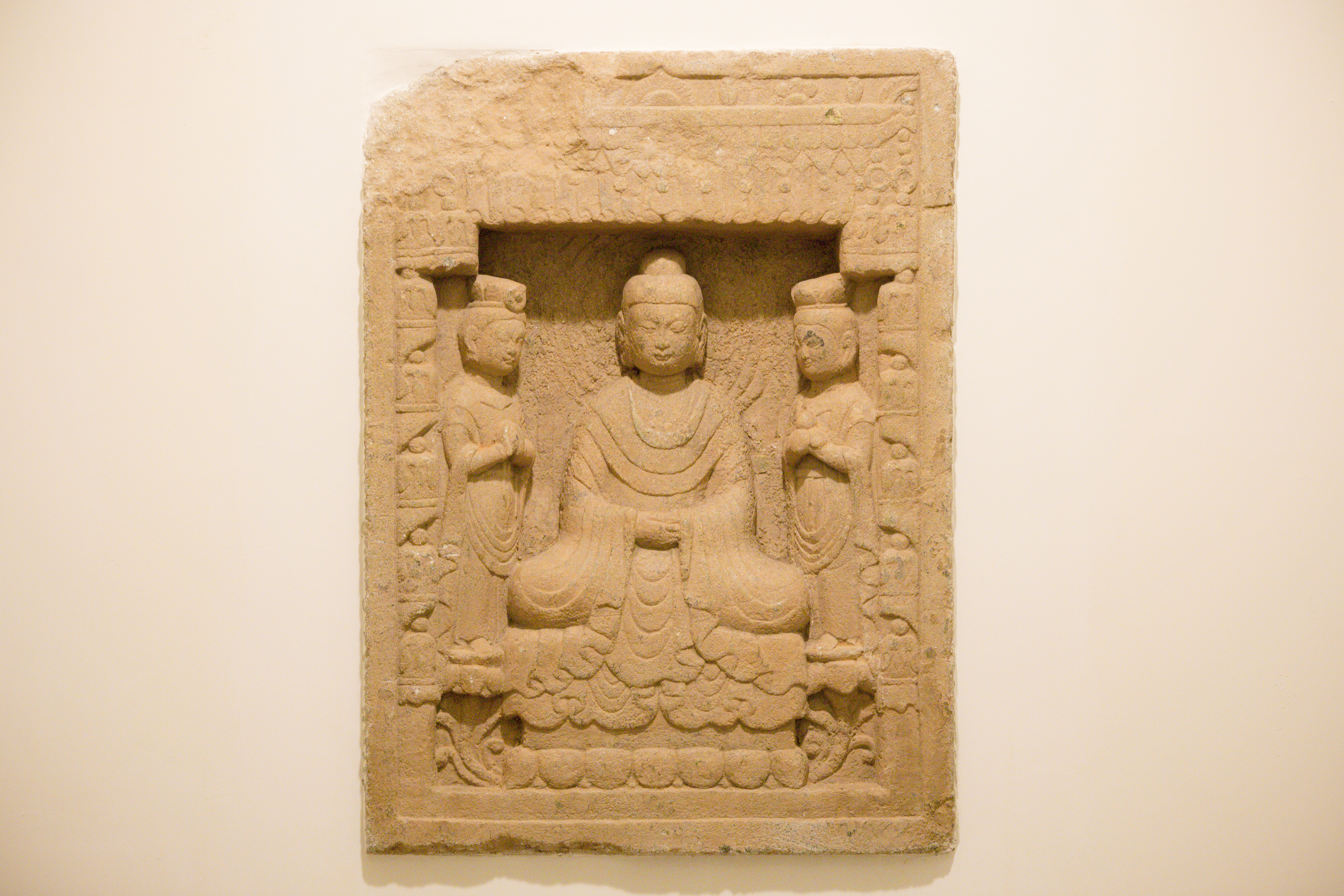
Created using a process called lost-wax casting, some bronze Buddhas, particularly from Tibet and China, contain a sacred object in their hollow interiors, George says—a relic or small manuscript inscribed with a prayer that was sealed inside the Buddha at the time of its consecration. The base under a Buddha may provide additional information about the statue. “These often include iconography—like a Tibetan vajra, symbolizing the indestructible, diamond-like hardness of enlightenment—and on the base an inscription identifying the object, and sometimes its donor,” says George. “Often these pieces were given by donors to obtain merit or overcome obstacles.”
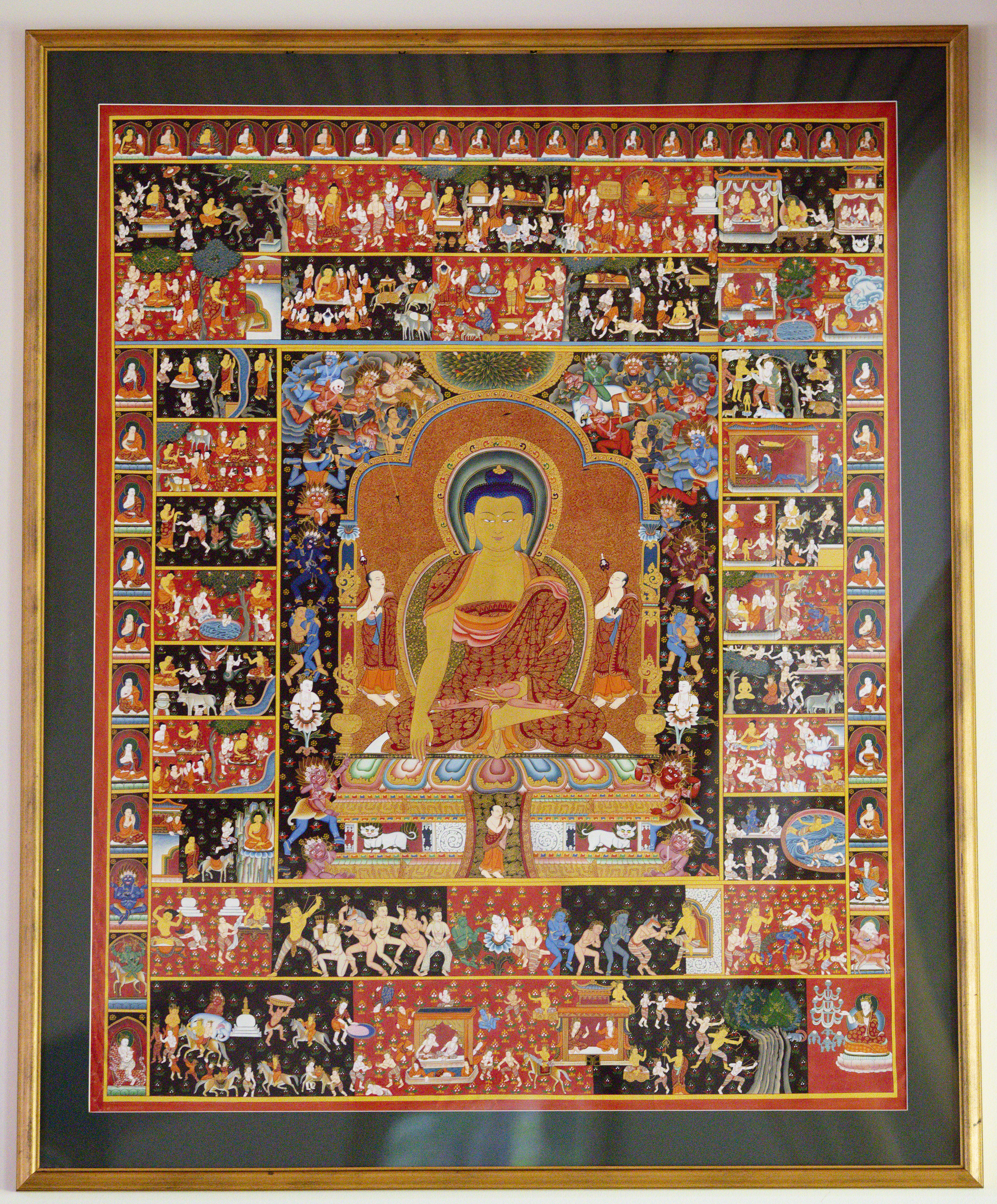
As a focal point of meditation, a thangka, or “recorded message” in Tibetan, is a scroll-like painting full of symbolic meaning that is intended to serve as a visual map for contemplative experience. The thangka that hangs in the Forest Refuge dining room offers a vibrant, mesmerizing example of the narrative power of Buddhist art. Hand-painted on silk, and likely 19th-century Chinese, this thangka features the Buddha performing the earth-touching gesture, with two disciples, or arhats, at his side. The Buddha is framed geometrically within successive layers; the outer borders show the Buddha in different seated postures and the inner layers depict various events from the Buddha’s life. In the final frame, just outside the mandala, some 30 demons, deities, humans, and beasts are stirring up all sorts of tumult—hanging upside down, fighting, dancing, having sex. A few of the demons are firing arrows at the Buddha, three of which pierce the membrane of the Buddha’s protective mandala but don’t hit him.
“This thangka captures much of what I love and find inspiring about Buddhist art,” says Bonnie Pitman, an IMS yogi who is the former director of the Dallas Museum of Art and currently the Director of Art-Brain Innovations at The Center for BrainHealth at the University of Texas at Dallas. “Depictions of the Buddha convey such equanimity and calm, a solitary figure almost in a world of his own. But here we see the Buddha surrounded by what we all face daily—conflict, distress, distractions both pleasant and unpleasant, threats to our safety and security. All of that painting’s frenetic activity—talk about monkey mind! We can relate to that. And yet, in the center of it all, the Buddha remains serene and unfazed, focused on his teachings and on sharing them.”
The two stained-glass windows in the upper walking room are remnants from the days when IMS was a Catholic novitiate. Ram Dass, the late spiritual teacher and longtime friend of IMS, sat a few retreats here in the early days, and in a 2011 interview with Inquiring Mind, he recalled that he preferred to do walking meditation between these windows. Here, he said, “I felt the bhakti, the love that I love to feel.”
